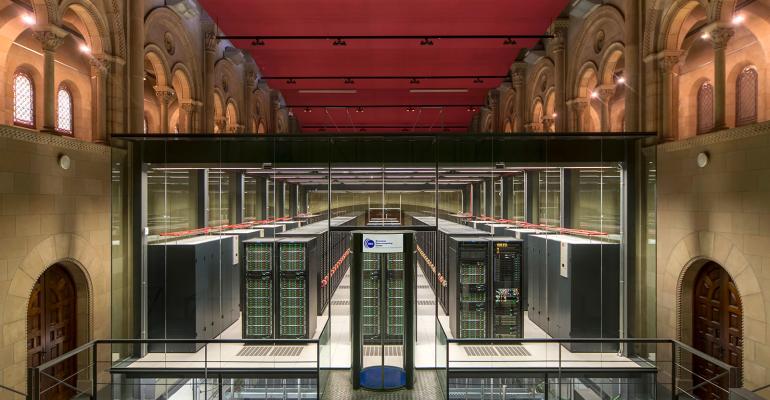When you think of data center construction projects, the image of massive plots of undeveloped land in remote areas likely comes to mind. While acquiring vast parcels is a common strategy in data center construction, this isn’t the only viable option.
Adaptive reuse projects, where existing buildings are converted into data centers, are gaining popularity. With the emergence of remote work and e-commerce, we see an increase in available, affordable office, retail, and warehouse space in urban areas.
This availability allows data center owners to take advantage of the many benefits of adaptive reuse data center projects. First, these projects are beneficial for bandwidth-hungry end-users located in and near urban centers, where the available real estate necessary to build from scratch is limited. Additionally, these structures have existing power and network access. These data centers can become operational with less time and fewer materials, which is especially valuable given the growing capacity demand.
While the benefits of adaptive reuse projects in data center construction are clear, existing structures have inherent limitations that require a different kind of stakeholder interaction than ground-up projects. With conventional pre-project planning techniques, the risk of costly delays rises considerably.
By implementing the following five strategies, appropriate alignment between stakeholders can ensure adaptive reuse data center project success.
1. Project Goals: Define the Big Picture
Begin by identifying the adaptive reuse project’s top-line ideas and, perhaps most importantly, identifying the challenges or problems that will likely arise during pre-construction and execution. These include historic preservation requirements, site access constraints, increased engineering complexity for power distribution, cooling, and other essential infrastructure systems, and other site-specific challenges.
Unlike greenfield data center projects, which can more easily allow for design consistency and repeatability with each building iteration, adaptive reuse projects are all necessarily unique. They will require more collaboration between owners, engineers, architects, and contractors to ensure that all requirements can be satisfied within the existing structure. Identifying and communicating anticipated obstacles early fosters the stakeholder alignment needed to prevent budget overruns, schedule slips, and unfulfilled owner expectations.
2. Establish a Shared Vision for the Adaptive Reuse Project
Working toward common goals prevents unnecessary mistakes borne of misunderstanding. In adaptive reuse data center construction projects, stakeholders must identify and document the essential subtleties to achieve consensus and create an achievable and realistic pre-project plan that defines the requirements and removes the confusion that can derail alignment.
Creating an effective pre-project plan starts with translating the project requirements into documents that specify principles, guidelines, and imperatives for the project. These documents become the means to explain the project to a broader group of stakeholders and properly direct their activities.
During this time, creating a governance structure that defines the process and assigns responsibility for oversight, decisions, and controls is vital. Governance should also address the roles and responsibilities of those within that structure. Doing so removes a great deal of confusion about who is responsible for what and when they should be doing it.
3. Create a Comprehensive Implementation Plan
Once the project has established the documented basis for a shared vision, create a comprehensive implementation plan (CIP). A CIP drills deeper into the shared vision and identifies specific requirements, cost estimates, and construction project schedules. In this phase, you create a strategy for procuring the architects, engineers, and contractors for the project.
Given the unique nature of each adaptive reuse project, these stakeholders must have a proven track record for compatibility, trust, and collaboration. Challenges will require continuous communication to ensure work is completed promptly. Stakeholders must work as a team instead of three separate entities adhering to their individual goals and priorities.
4. Refine Vision Requirements
Every obstacle has the potential to create a ripple effect that impacts team members, including engineers, architects, and contractors, and you must be prepared to refine vision requirements as necessary. Conduct a series of designing and scoping workshops that refine every aspect of the vision and create both the framework and the strategic direction of the project that the architects and contractors can then implement.
These workshops involve all key stakeholders and are where we identify and address potential black swan events. These are situations that may arise unexpectedly but could have a significant effect, either positive or negative, on the project’s progress. This exercise allows the team to create a project decision framework early on to prevent or limit delays and to keep work going. By taking the time to establish what the owner really cares about early, you can develop the project requirements in a way that streamlines alignment and sets the stage for faster, more efficient execution.
5. Manage Compliance With the CIP
A CIP is only as effective as the owner’s ability to enforce it. It is critical to engage a dedicated team – whether internal or a third party – to ensure that the CIP is carried out via oversight and management of project alignment. Very often, a third-party architect or project manager who specializes in large, complex projects can help offer a more objective point of view because they are not as intimately involved with the project or stakeholders.
Alignment is critical to the success of an adaptive reuse data center construction project. But it doesn’t just happen. Keeping stakeholders on the same page requires forethought and diligence from start to finish. By following these five suggestions, you can limit the number of challenges a project will encounter and more quickly and easily mitigate the challenges that do arise. The result is a project that is on time, is on budget, and delivers on the owner’s expectations.
David Hart, FAIA, Executive Vice President, MOCA Systems, Inc.





